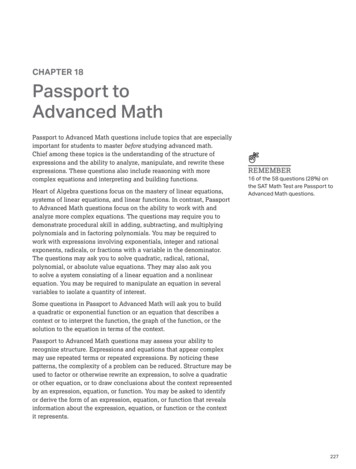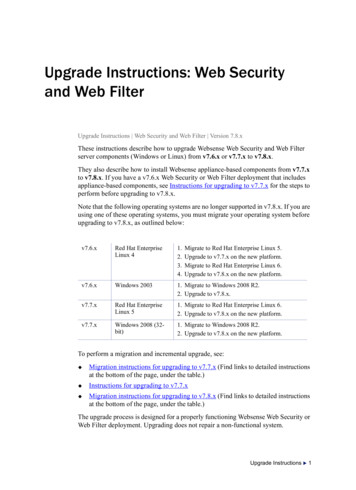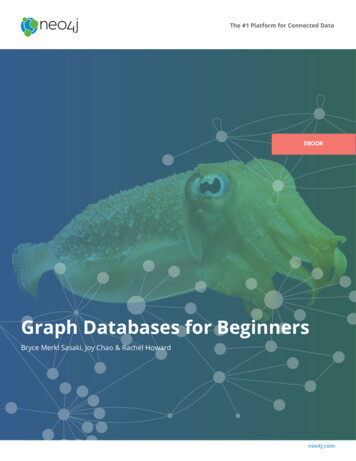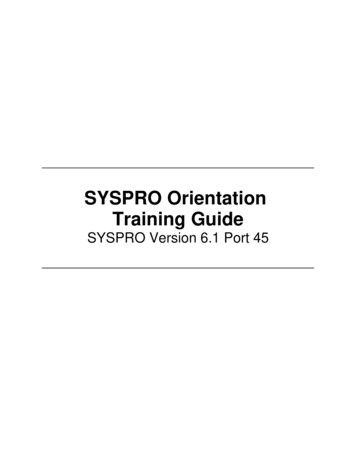
Transcription
Advanced topics in databases:Introduction to Prolog as a database languageA course noteHenning ChristiansenRoskilde University, Computer Science Dept.c 2003Version 24 feb 2003Contents1 Introduction and overview2 Prolog as a simple database engine2.1 The subset of Prolog called Datalog2.2 Example: Logical circuits in Prolog .2.3 How Prolog answers queries . . . . .2.4 A logical semantics for Prolog . . . .2.5 Predefined predicates . . . . . . . . .2.6 Exercises . . . . . . . . . . . . . . .3.339111418193 Negation-as-failure in Prolog203.1 Exercises . . . . . . . . . . . . . . . . . . . . . . . . . . . . . . . . . . . . . . . . . . 234 Translating relational algebra and integrity constraints into Prolog244.1 Exercises . . . . . . . . . . . . . . . . . . . . . . . . . . . . . . . . . . . . . . . . . . 265 Hacks and features that make Prolog into a general programming language5.1 Data structures . . . . . . . . . . . . . . . . . . . . . . . . . . . . . . . . . . . . .5.2 Lists in Prolog . . . . . . . . . . . . . . . . . . . . . . . . . . . . . . . . . . . . .5.3 A collection of more or less logical built-in predicates . . . . . . . . . . . . . . . .5.3.1 Procedural test predicates . . . . . . . . . . . . . . . . . . . . . . . . . . .5.3.2 Control . . . . . . . . . . . . . . . . . . . . . . . . . . . . . . . . . . . . .5.3.3 Arithmetic in Prolog . . . . . . . . . . . . . . . . . . . . . . . . . . . . . .5.3.4 Finding all solutions to a query . . . . . . . . . . . . . . . . . . . . . . . .5.3.5 Input/output . . . . . . . . . . . . . . . . . . . . . . . . . . . . . . . . . .5.4 Having programs to inspect and modify themselves during execution . . . . . . .5.5 Syntactic extensibility . . . . . . . . . . . . . . . . . . . . . . . . . . . . . . . . .5.6 Exercises . . . . . . . . . . . . . . . . . . . . . . . . . . . . . . . . . . . . . . . .1.262729323233353739394446
6 Playing with updates and integrity checking6.1 A straighforward and inefficient implementation of integrity enforcement6.2 Simplified integrity constraints . . . . . . . . . . . . . . . . . . . . . . .6.3 Conversational update routines . . . . . . . . . . . . . . . . . . . . . . .6.4 Exercises . . . . . . . . . . . . . . . . . . . . . . . . . . . . . . . . . . .7 Extensions to Prolog7.1 Constraint logic programmingNot included in present version . . . . . . . . . . . . . . . . . . . . . . . . . . . . . .7.2 Constraint Handling RulesNot included in present version . . . . . . . . . . . . . . . . . . . . . . . . . . . . . .7.3 Grammar notations in Prolog and in CHRNot included in present version . . . . . . . . . . . . . . . . . . . . . . . . . . . . . .4849495151525252528 Abduction in logic programming and its application to databasesNot included in present version529 A few thoughts about a revision and extension of this note522
1Introduction and overviewThis note gives a practical introduction to Prolog under a database perspective. Prolog is interestingfor students and researchers in the database area for a number of reasons: Prolog itself may serve as a prototype database language as relational algebra can be expresseddirectly, including tabular relations, views and integrity constraints. Prolog is a programming language that is very easy to learn and in which it is fairly straightforward to implement and experiment with different database functionalities. Prolog is based on first-order logic so that programs have a clear semantics that can refer toa large body of knowledge and tradition. It represents live logic in a way that is much more appealing than a myriad of Greek lettersand strange symbols on paper. And a good supplement to or a starting point for the one whowants to dig into the database literature which is inherently loaded with logic.We do not, in general, advocate to use Prolog for storing really large amounts of data, as traditionaldatabase systems are much better for this purpose. The real advantage of Prolog in this context isas an experimental tool, which can give a clearer understanding of underlying concepts and serveas workbench for developing new methods in the shape of running prototypes. It is much easier toplay with different variations of some advanced database functionality in a Prolog program thandoing so by modifying the source code of a big relational database system!In what follows, we introduce Prolog to a level which is intended to make it possible for thereader to write interesting and working Prolog programs, and to see the similarity with databaseson the one side and logic on the other. We explain also basic semantic notions of Prolog as they areuseful for the understanding of databases and their semantics in general. For the interested reader,it should be mentioned, however, that there is much more to the semantics of logic programmingthan the soft and minimal introduction given here.This is an early version of this note which has been written in a very short time, so (hopefully only)minor errors can be expected here and there. There are not as many references to the literature yetas will be included in a possible future revision, and no reference list is included. The author kindlyasks for his readers patience :)22.1Prolog as a simple database engineThe subset of Prolog called DatalogProlog is a programming language based on a subset of first-order logic and the syntactic andsemantic notions of Prolog are more or less taken over from logic. There are, however, a few (andoccasionally quite unfortunate) clashes in usage between the two worlds that will be noticed in thesequel, mostly as footnotes.In the following we introduce the basic elements of the Prolog language, which coincide withthe subset called Datalog; it contains sufficient expressive power to express relational algebra andis actually a generalization of it in several directions.3
The basic entity in Prolog that corresponds to operations and procedures in programminglanguages and to relations in relational databases is called a predicate (symbol). A predicate takesa number of arguments, and this number is called the arity of the predicate. The notation p/2refers to a predicate with name p and arity 2, and p(a,b) is an example of an atom.1The different arguments can be either constant (symbol)s or variables. Syntactically, a variableis distinguished from other items as it starts with a capital letter or an underline. Examples ofProlog variables:XYMonkeyMonkey 17 aBcD117The variable name spelled as one underline character has a special meaning that is explained later;variables of the form “ number” should be avoided as Prolog uses such when printing out internallygenerated variables.Constants are the basic data values that Prolog works with; generally a constant denotes itself,i.e., constant a is (and refers to) a symbolic value that we can only refer to as a and which isdifferent from any other constant, say b. Constants can be written in different ways: starting with a small letter followed by sequences of letters, underlines, and digits:monkey, mOnKeY, m 1o nkey, numbers: -1, 0, 1, 117, 3.14, sequences of one or more special characters, however, excluding brackets, single and doublequotes, the vertical bar, and the percentage sign; a few restrictions may apply, consult yourProlog manual in problematic cases: , , @@*@@, , arbitrary sequences of characters2 surrounded by single quotes:’Monkey’, ’monkey’, ’ ’, the specific sequence [] which serves a specific purpose in Prolog’s list notation (see section 5.2); it is, in fact, possible to write spaces between the square brackets and it is stillrecognized as this atom.Notice that a constant which can be written without quotes is the same as the one written thesame way with brackets, e.g., monkey and ’monkey’ are the same thing. The constant ’Monkey’can only be written in one way as removing brackets yields a variable Monkey that is by no meansrelated to the constant ’Monkey’.1We use here the vocabulary most often used in the literature on mathematical logic. Standard Prolog usageapplies “atom” to mean “constant symbol”, and what in standard logic is called an atom (such as p(a)) is in Prologcalled a (simple) goal.2A single quote inside a quoted constant symbol is indicated writing it twice; for example ’’’’ represents theconstant whose name is a single quote.4
The fundamental building brick for Prolog programs is the atom which is a conglomerate ofpredicate and arguments which are either variables or constants. Example: p(a,X). (A third kindof arguments called structures is introduced in section 5.1.The first Prolog program we show looks as follows and it does not write “Hello World!”.father(john, mary).This program consists of a single fact; syntactically a fact is an atom followed by a period. Oneway to understand such a program is as a database. The logical meaning of this program is simplythe set of facts {father(john, mary)}. Rephrased in database terminology, the program definesa relation referred to by predicate father/2 which contains the tuple {hjohn,maryi}.There is no sense in executing a Prolog program, but we can execute queries to a given program.The following sample dialogue with a Prolog system shows first how the program is read into thesystem (“consulted”) and a first query is given; the characters “?-” are the system’s prompt.?- [family0].File family0 consulted in 117 ms?- father(john,mary).yes?- father(maggi,frede).noThe program is expected to reside in a file called family0 in this example. The first query succeeds,indicated by the system’s reply yes, since father(john,mary) is in fact known by the database.The second query fails indicated by the system’s reply no, since father(maggi,frede) is not knownby the database.Queries may contain variables:?- father(john,X).X mary ?;noThe query reads “are there any values of X that make father(john,X) hold in the database?” Thesystem replies “X mary ?” whose meaning is obvious: the question mark indicates to the user thata response is expected. Typing end-of-line means that the user is satisfied with the answer returned,and semicolon (as in the example) means to ask the system for possible alternative solutions; forthis little program there are no more possible values for X that satisfy the query, hence the system’ssecond response “no”.A pragmatic note: As it appears, the Prolog system is an interactive environment that (inmost cases) resides in an old-fashioned line-oriented operating system. Under MacOs X, one needsto open a Unix terminal in order to run SICStus Prolog, and similarly under Windows where acommand-line window needs to be opened. A plain text editor is the tool which is needed to editProlog programs. Libraries for writing graphical interfaces in Prolog are available for differentversions and it is possible to interface to Java and C, but in general this is a bit difficult.Another pragmatic note: No explicit declarations are needed for introducing the symbols usedin a Prolog program. Predicates, constants, and variables can be used directly and be thoughtof as pre-existing and available in any program. This creates obvious problems when something5
is misspelled but most Prolog systems issue certain warnings which catch most but not all cases.The shortest Prolog programs consist of two characters, e.g., “p.”, which defines a program witha nullary predicate, i.e., a predicate with zero arguments, which is written without a pair of emptybrackets.Let us extend the program above with more facts so that we can show more interesting queries:father(john, mary).father(john, karen).father(paul, john).The programmer who wrote the program probably has in mind a part of a family consisting of fourpersons, Paul be the oldest, father of John who in turn is father of Mary and Karen. According toour experience, Paul is then grandfather of Mary and Karen. However, the system has no everydayknowledge, in fact no real knowledge at all: it is able to play around with symbols and no more.The relation between real world objects and the symbols is a convention and interpretation of theprogrammer who is responsible for the correctness of this mapping.About failure, it should be made clear that the answer “no” to a query Q does not mean thatthe real world interpretation of Q is false (in the real world); it simply means that the program( the database) does not contain information about Q. It may be the case that the database ( the program) contains all information that characterizes the defined predicates in some real worldsense and it may be the case that the database is an incomplete or approximate description of theworld.Now back to the sample program and let us pose a compound query:?- father(paul,X), father(X,Y).This query consists of two atoms (each of which is referred to as a subgoal) and contains twovariables, one of which recurs in both atoms. The meaning of the query is to ask for pairs of valuesfor X and Y so that the query holds in the database. More precisely pairs of values so that, whenthey are substituted simultaneously into the variables’ positions into the entire query, it providesa collection of facts that holds in the database. Thus we get the two answers (notice that the usertypes twice semicolon):?- father(paul,X), father(X,Y).X john, Y mary ?;X john, Y karen ?;noIt is obvious that the everyday interpretation is to ask for a grandchild Y of Paul, and in order todo this we must include the intermediate link X in the query.Any interesting programming language contains one or more abstraction mechanisms. We candefine an abstraction mechanism informally as a device which makes it possible to put together acompound expression and refer to it by a name in some way. The word “abstraction” means herethat once we got used to the new named thing we can forget all about its definition and just applyit; hopefully the name indicates some real notions. In Java we have classes and methods and inProlog we have rules. The grandfather relation inherent in the query above can be abstracted intothe following rule:6
grandfather(X,Z):- father(X,Y), father(Y,Z).The meaning is (informally) that grandfather(X,Z) holds for some X and Z whenever there issome Y so that the query father(X,Y), father(Y,Z) succeeds. With this clause in the programwe can now ask queries involving the grandfather predicate:?- grandfather(paul,X).X mary ?;X karen ?;noThere is an obvious similarity between a Prolog rule and the definition of a view in a database;we consider the similarity between Prolog and SQL in more detail in section 4. It is interesting toobserve that the definition of the grandfather predicate is correct with respect to the everydayinterpretation independently of which father facts are in the database ( program).In general, a new predicate may be defined by more than one rule. Consider the following predicate ancestor that is supposed to include father relations, grandfather relations, greatgrandfatherand so on.ancestor(X,Y):- father(X,Y).ancestor(X,Z):- father(X,Y), ancestor(Y,Z).This predicate is recursive and recursion is basically the only sort of looping that is possible inProlog.3Rules and facts are collectively called clauses and the set of clauses defining a given predicateis called the definition for that predicate. The meaning is that the predicate holds for some valuesif either the first clause succeeds, or the second one does, or the third one, etc. As it went fora program of facts only, so it does for the two-rule definition of ancestor above: An ancestorrelation holds if either a direct father relation holds or a combination of a father relation holdstogether with another ancestor relation (which in turn may stem from a father fact or yet anothernested father-ancestor combination).Finally we explain the use of the anonymous variable which is written as an underline character.Here is an example:father(X):- father(X, ).Here, the anomymous variable could equally well have been written here as an ordinary variable,say Y. In order to cope with the problem of misspelling, Prolog issues a warning whenever a variableoccurs only once in a clause, but this is suppressed in case the anonymous variable is used. Thusthe advice is to use the anonymous variable in case you really intend to have a variable that occursonly once in a clause.To be more precise, each occurrence of “ ” stands for a new variable, thus f(X,X) and f( , )mean two very different things; the last one unifies with f(a,b) but the first one does not (unification defined below).3There are a few other ways to produce phenomena that are analogous to loops in imperative programminglanguages, but this belongs to the less logical parts of Prolog that we shall avoid except when there is a good reasonfor it.7
When a predicate is defined by more than one clause, these clauses work together in an “or”fashion. A goal succeeds if it succeeds with the first clause, or with the second clause or, . Prologincludes a syntax that represents “or” within a clause. This is useful when two clauses are almostidentical except for a few details. For example, the clausea(X,Y,Z):- b(X,Y), (c(Y,W,p) ; d(X,Y,Z,W)), e(W).can be understood as an abbreviation for the following two clauses.a(X,Y,Z):- b(X,Y), c(Y,W,p), e(W).a(X,Y,Z):- b(X,Y), d(X,Y,Z,W), e(W).Semicolon works, thus, as an “or” operator within a clause body; however, as it can be defined asa kind of syntactic sugar (abbreviating a more complicated expression made without semicolon),we need not consider semicolon when describing Prolog’s semantics in details.Summary of Prolog so far: The subset of Prolog we have shown until now has been given thename Datalog and has been used in database research, as it provides sufficient expressive power toexpress relational algebra (we return to this point in section 4). A program is a finite set of clauses. A clause is either a fact of the form “head.” or a rule of the form “head:-body.”. A head is an atom and a body is a sequence of atoms separated by commas. In the context of trying to prove a query, the notion of a goal refers to a conjunction of one ormore atoms to be proved (or disproved), originating either from the query or an expressionresulting from the application of a rule; each atom in a goal is called a subgoal. A goal has the form predicate-name( argument, . . ., argument ) where each argument is aterm, which in Datalog is either a variable or a constant symbol. We have not introduced this above, but it is customary in Datalog to split the predicates of aprogram into extensional and intensional ones; extensional predicates are defined by groundfacts only and the intensional ones by at least one rule,4 . . where a ground fact is one without variables; in general, “ground” means variable-free.We may occasionally use the term “ground fact” also to refer to a ground atom. Informally the semantics of a Datalog program is a database in which the extensional predicates correspond to tables and the intensional ones to views. Programs are executed by posing queries which are compound goals, perhaps with variables.The system returns as result, if possible, values for the variables with which the query can beseen as a member of the database.4Facts with variables may be useful in Prolog programs, but are problematic in database applications as we willsee later.8
2.2Example: Logical circuits in PrologThis example is not so much related to database applications of Prolog but serves to illustrate thediversity of problems that can be described elegantly in Prolog.We consider logical circuits, which are a graphical formalism that serves as an abstract model ofa class of electronic circuits composed by conductors and gates that can be thought of as performinglogical operations. A physical component corresponding to the “not” gate below behaves in thefollowing way: If a potential of about five volts is imposed on the input connector to the left inthe diagram below, a potential of about zero volts can be observed at the output connector to theright (and the other way round for an input of about zero volts). The actual technology may bebased on another pair of voltages than roughly five/roughly zero; the only interesting property isthat the gates behave in a consistent way with respect to the logical behaviour. The presentation ismore or less self-contained; if a more detailed introduction is needed, we may refer to (Tanenbaum1999, chap. 3).We represent the value corresponding to logical “truth” by the constant symbol 1 and logical“falsity” by 0. The fact that these symbols in some context may serve as numbers in Prolog is ofno interest here; we could in principle have used any other pair of two distinct constant symbols.A given gate (or circuit) can be defined as a predicate whose argument represents the gate’s (orcircuit’s) input and output connectors. A “not” gate, for example, can be specified by the followingtable.notAXA01X10The corresponding definition in Prolog is the following sequence of facts, one for each row in thetable.not(0, 1).not(1, 0).“And” and “exclusive-or” gates are specified in similar ways, and so on for gates corresponding toother logical 110
The corresponding predicates and(A, B, X) og xor(A, B, X) are defined as ).xor(0,xor(0,xor(1,xor(1,0,1,0,1,0).1).1).0).In the graphical language, gates are put together by connecting the components by means ofconductors. In Prolog, we can do very much the same thing, except that we use variables insteadof conductors. The following picture shows a so-called half-adder circuit.ASumBCarryIt can be described by a predicate defined as follows.halfadder(A, B, Carry, Sum):and(A, B, Carry),xor(A, B, Sum).It is interesting to recall electric science’s definition of a(n ideal) conductor as a body which hasthe same potential everywhere: x volts in one end means x volts in the other end as well as in anyintermediate point. A Prolog variable works exactly the same way within a rule: In an applicationof a rule (defined formally as “an instance” later), each variable has the same value throughoutthe rule. In principle, we could replace the rule by all possible such instances that may arise whenputting values for variables, adder(1,1,1,0):and(1,1,1),xor(1,1,0).The following more complicated circuit is known as a full adder.Carry inASumBCarry out10
It involves some internal conductors that are not connected to the circuit’s external connectors.In the Prolog version, these conductors are replaced by variables that recur in the subgoals of thebody but do not occur in the head, here X, Y, and Z.fulladder(A, B, Carryin, Sum, Carryout):xor(A, B, X),and(A, B, Y),and(X, Carryin, Z),xor(Carryin, X, Sum),or(Y, Z, Carryout).The program explained in this section is a model of a physical system and we can use the programto predict properties of this system. We may, for example, pose a query that for a given set ofinput values (abstract potentials) calculates the output values.?- fulladder(0, 1, 1, S, C).S 0, C 1 ? ;noThis shows that the circuit for adding a 0 and a 1 given a previous carry of 1 produces sum 0 withnew carry 1, and it appears that this is the only solution.Contrary to the physical system, we can also evaluate which inputs are necessary in order toproduce given output values.?- fulladder(X,X 0, Y 1,X 1, Y 0,X 1, Y 1,no2.3Y, Z,Z 1Z 1Z 00, 1).? ;? ;? ;How Prolog answers queriesIn general, we distinguish between Prolog’s declarative and procedural semantics. Declarativesemantics means a logical specification of what answers Prolog ideally should produce; it is basedon an understanding of clauses as first-order formulas, considered in detail in section 2.4. Proceduralsemantics, that we consider here, means an abstract description of how, and in which order, thesystem performs simpler operations to achieve an answer.A central notion used in the description of both the declarative and procedural semantics isthat of a substitution. A substitution is a mapping of variables to terms and is used for (amongother things) specializing clauses so that they fit specific goals. By tradition, we use Greek lettersto refer to substitutions and postfix notation for applying. So we may have a substitution σ thatmaps variable X to term a and Y to b; this can be specified Xσ a, Yσ b.Applying a substitution to an expression means to apply it simultaneously to all variables in thatexpression. Let, for example, σ refer to the substitution above and let the expression in questionbe the clause p(X,Y):- q(X,Y). In this case we may write as follows:(p(X,Y):- q(X,Y))σ (p(a,b):- q(a,b))11
In this example, we can say that σ is applied for specializing the clause so that it fits perfectly forthe processing of the query ?- p(a,b), i.e., in order to have p(a,b) to succeed, the specializedclause says that we might obtain this if we can have q(a,b) to succeed (involving whatever clausesmight be available concerning q).For any expression E and substitution σ, we refer to the image Eσ as an instance of E.We need to introduce the composition of two substitutions which means no more that applyingthem one after another. The composition of substitutions σ and θ is written simply as σθ (“firstσ then θ”). So if σ maps a variable X to some term t, and another substitution θ applies to thevariables of t, we have that Xσθ tθ.Let, for example, substitution α be defined by Xα a (and leaving all other variables untouched), and substitution β similarly by Yβ b. We have, then, the following:p(X,Y)α p(a,Y) and p(X,Y)αβ p(a,Y)β p(a,b).Some special kinds of substitutions are useful. A renaming substitution for an expression E isone that replaces each variable occurring in E by another distinct variable. So one renamingsubstitution for the clause shown above as one that we may call ρ with Xρ X1 and Yρ Y1. Withthis we have(p(X,Y):- q(X,Y))ρ (p(X1,Y1):- q(X1,Y1))In a case like this, we refer to the new clause as a variant of the original clause. In case the variablessubstituted in by ρ have not been used before, we talk about a fresh variant. The ability to drawnew, fresh versions of a given clause is similar to what we have in a traditional programminglanguage with recursive procedures or methods: Whenever a procedure is called, a new stack frameis allocated for the local variables and parameters of that procedure. In this way, each procedurecall works in its own local variable space without mixing up different calls.We talk also about a grounding substitution for a clause (or any other expression) if it replacesany variable in the clause by a ground term. So, for example, the substitution given by Xσ a,Yσ b is grounding for the clause p(X,Y):- q(X,Y).Finally, we introduce what is called a unifier of two expressions E and F , which is a substitutionσ such that Eσ F σ. Unifiers are relevant when we compare a given goal G with the head H of aclause H:- B. The existence of a unifier of G and H means that the clause might be a candidatefor having G to succeed.In general, we are only interested in the most general unifier of two terms. The definition ofthis is a bit technical: A unifier σ of E and F is most general if, for any other unifier θ of E and F ,it holds that θ σγ for some substitution γ. The common instance Emgu(E, F ) F mgu(E, F )is called the unification of E and F . If no mgu(E, F ) exists, we may say that the unification of Eand F fails.A unifier σ being most general simply means that any other unifier is a specialization or avariant of σ.Let us consider a few examples. The most general unifier of two goals mgu(p(X,a), p(Y,a))exists and is a substitution which maps X and Y to the same variable (or, alternatively, X to Y orthe other way round). There is no mgu(p(X,a), p(Y,b)) nor an mgu(p(X,X), p(a,b)).The fundamental step in the execution of a Prolog program is the unification of a goal to beevaluated with the head of a clause. As a very simple example of this, consider a program consisting12
of one fact p(a). The query p(X) succeeds with answer X a because mgu(p(X),p(a)) maps X toa.When there is more than one clause matching a given goal, the different clauses are tried outone by one starting with the textually first one. For simplicity, however, we describe the executionof a goal in a nondeterministic fashion, so that an arbitrary clause is chosen. When some clauseH:-B clause is chosen for the execution of A, the body B is executed similarly to a recursiveprocedure: The subgoals of B are executed in sequence, and the control is returned to whatevergoals follow A.To execute a query ?- G1 , . . . , Gn we assume a state containing a substitution referred to by αwhich gets more and more specialized as the execution continues and eventually holds a substitutionthat provides an answer (unless some unification fails along the way). The overall execution of thequery is initiated in the following way.α : the empty substitution;execute the queryG1 , . . . , Gn ,print-solution,where print-solution is a pseudo-goalThe details of execution of composite and primitive goals are described as follows.1. To execute a sequence of atoms G1 , . . . , Gn means to execute first G1 with the current αproducing a new substitution that we call α1 ; now G2 is executed starting with α1 producingα2 and so on, until Gn has produced αn which is the resulting, new value of α.2. To execute the pseudo-goal, print-solution, print out α and stop.3. To execute an atom G, locate a clause with a fresh variant H:-B (or a fact H in which caseB refers to an empty body) with
versions and it is possible to interface to Java and C, but in general this is a bit difficult. Another pragmatic note: No explicit declarations are needed for introducing the symbols used in a Prolog program. Predicates, constants, and variables can be used directly and be thought of as pre-existing and available in any program.










